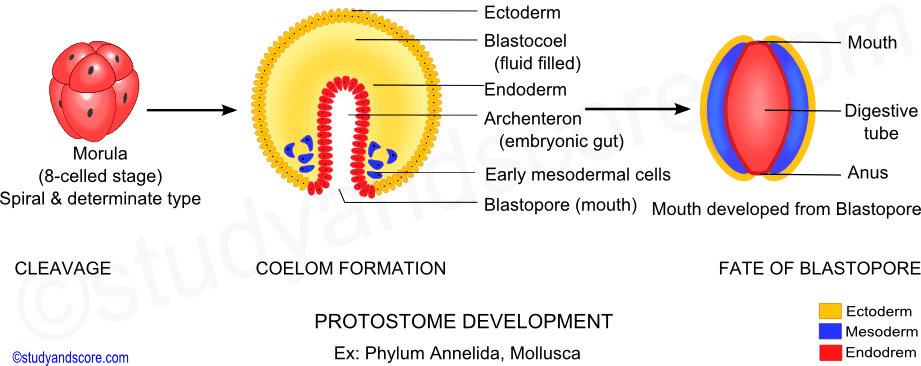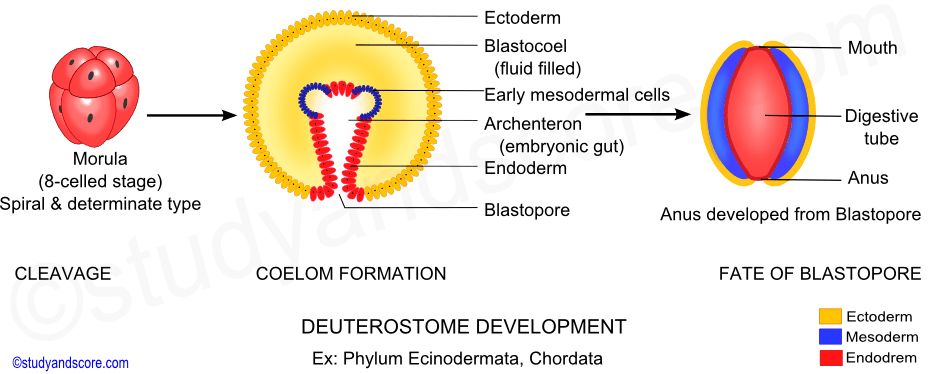Protostomes and deuterostomes along with few other smaller phyla constitute the grade bilateria. The major difference between deuterostomes and protostomes are found in early embryonic development. During the early embryonic stages of animal development, zygote undergoes rapid cell divisions called as Cleavage to produce a compact mass of cells called Morula. The different cells derived from the cleavage are called as blastomeres. Cleavage ends with the formation of Blastula. As the cleavage proceeds, the number of blastomeres increases and cells of blastula are arranged into a hollow ball like structure.
The central cavity of blastula is called as blastocoels. Invagination of endoderm and mesoderm cells at one end of the blastula is called gastrulation and this result in the formation of Gastrula. The open cavity of gastrula lined by endoderm is called Archenteron or primitive gut. Its opening is called as Blastopore. The outer layer of gastrula is the ectoderm and the inner layer is called as endoderm. And the cavity between the two layers is Blastocoel.
Occasionally the invagination during gastrulation may be incomplete and the blastopore is not fully formed which results in the formation of a primitive streak as seen in the embryo of bird or mammal. When the blastopore is not fully formed it is called virtual blastopore. During later developmental stages blastopore may develop either into mouth or anus.
Protostomes in Greek means mouth first. In protostomes, these early divisions occur at right angles parallel to the animal-vegetal axis of the zygote. This type of cleavage is called as spiral cleavage.

The type of cleavage in protostomes is also called as determinate type because the developmental fate of the cells in the developing embryo is determined by the identity of the parent cell. Thus, if the first four cells are separated, none of the cells can form a complete larva and if a cell is removed from blastula the other cells cannot compensate. In protostomes mouth arises from the anterior margin of the blastopore. Coelom is absent and a persistent pseudocoelom is present. Larval form exhibiting the protostome characters is Trochophore.
Deuterostomes in Greek means mouth second. In deuterostomes, the early divisions occur parallel or perpendicular to the animal-vegetal axis of the zygote. This type of cleavage is called as radial cleavage.

The type of cleavage in deuterostomes is also called as indeterminate type because the developmental fate of the cells in the developing embryo is not determined by the identity of parent cell. Thus, if the first four cells are separated, none of the cells can form a complete larva and if a cell is removed from the blastula the other cells will compensate.
In deuterostomes mouth arises anteriorly some distance away from the blastopore. Coelom is present and it is an enterocoel developed by the fusion of the gut pouches. Larval forms exhibiting the Deuterostome characters are Tornaria and Bipinnaria.
| Protostomia | Deuterostomia |
|---|---|
| Mouth arises from the blastopore or from the anterior margin of blastopore | Mouth arises anteriorly at some distance away from blastopore |
| Coelom absent, pseudocoelom persistent. Coelom deveoped as schizocoel by a split in mesoderm | Coelom developed as enterocoel by the fusion of gut pouches |
| Cleavage spiral and determinate | Cleavage radial and indeterminate |
| Larva Trochophore | Larva tornaria or bipinnate |
- Share with your friends! -
Login to post your comment here...
- or with social Account -